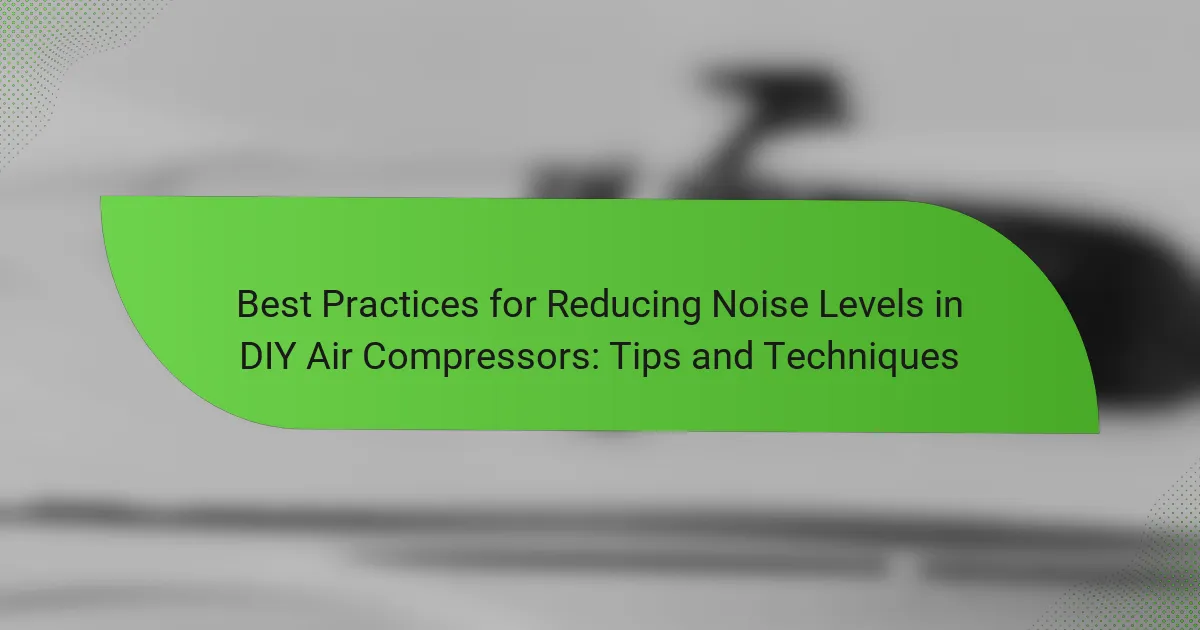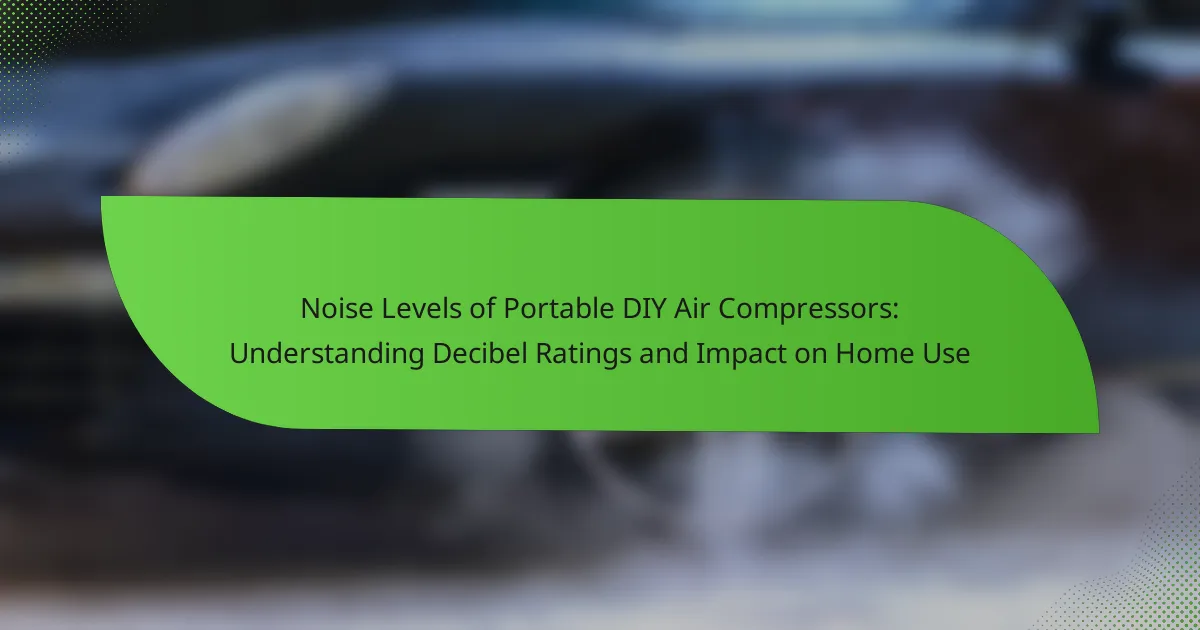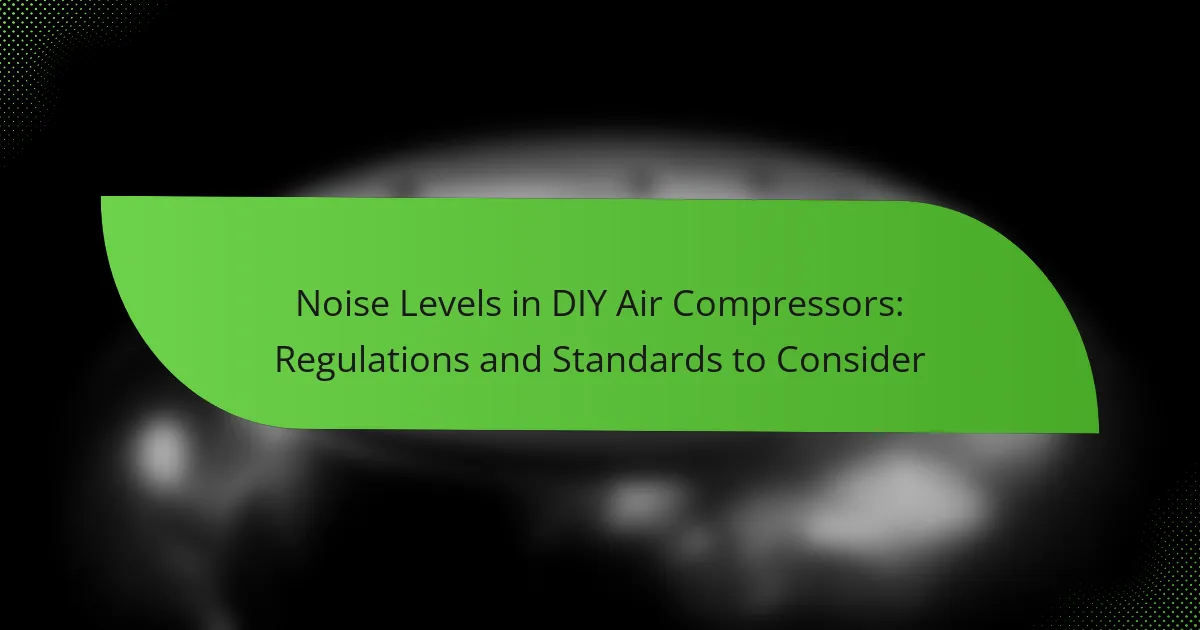Noise levels in DIY air compressors typically range from 60 dB to 90 dB, influenced by the type and design of the compressor. Oil-lubricated compressors tend to operate more quietly compared to oil-free models, with household compressors averaging around 70 dB, while industrial models may exceed 85 dB. Prolonged exposure to noise levels above 85 dB poses a risk of hearing damage, making hearing protection advisable. The article outlines various tools and methods for measuring these noise levels, including sound level meters, smartphone apps, and dosimeters, emphasizing the importance of calibration and data logging for accurate monitoring and compliance in different settings.
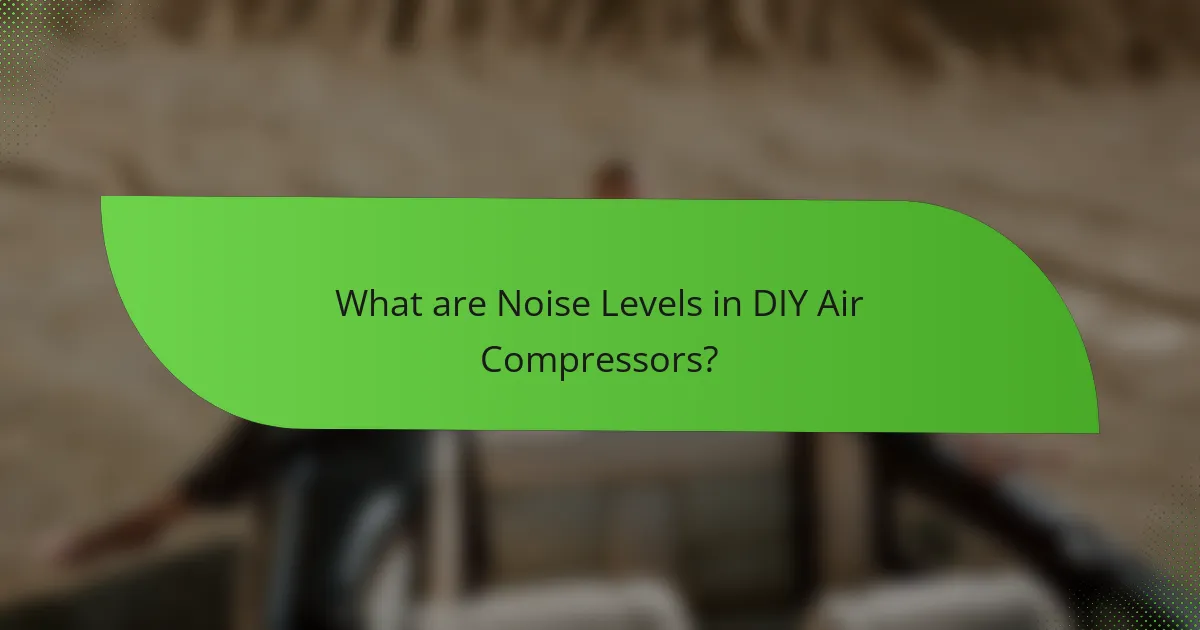
What are Noise Levels in DIY Air Compressors?
Noise levels in DIY air compressors typically range from 60 dB to 90 dB. This range depends on the compressor type and design. For instance, oil-lubricated compressors are generally quieter than their oil-free counterparts. A standard household air compressor may operate at around 70 dB. In contrast, industrial models can exceed 85 dB. Prolonged exposure to noise levels above 85 dB can lead to hearing damage. Therefore, it is advisable to use hearing protection when operating louder compressors. Manufacturers often provide noise level ratings in product specifications for reference.
How are noise levels measured in general?
Noise levels are measured using a sound level meter. This device quantifies sound pressure levels in decibels (dB). Sound level meters typically have a microphone that captures sound waves. They convert these waves into electrical signals for analysis. The readings indicate the intensity of sound in the environment. Calibration ensures accuracy in measurements. Noise levels can vary based on location and time. Consistent measurement protocols are essential for reliability.
What tools are commonly used for measuring noise levels?
Sound level meters are commonly used for measuring noise levels. These devices quantify sound intensity in decibels (dB). They are essential for assessing noise pollution and ensuring compliance with regulations. Dosimeters also measure noise exposure over time. They are particularly useful in occupational settings. Smartphone apps can provide basic noise level measurements. However, they may lack precision compared to dedicated devices. Integrating these tools helps in accurately monitoring noise levels in various environments.
What units are used to express noise levels?
Noise levels are expressed in decibels (dB). Decibels measure the intensity of sound. This unit is logarithmic, meaning each increase of 10 dB represents a tenfold increase in sound intensity. For example, a sound at 70 dB is ten times more intense than one at 60 dB. Common sounds are often referenced in dB. A whisper is about 30 dB, normal conversation is around 60 dB, and a lawnmower can reach 90 dB. Understanding these units is essential for measuring noise levels accurately.
Why is it important to measure noise levels in DIY air compressors?
Measuring noise levels in DIY air compressors is crucial for ensuring safety and compliance. High noise levels can lead to hearing damage over time. The Occupational Safety and Health Administration (OSHA) recommends keeping noise exposure below 85 decibels to prevent hearing loss. Additionally, measuring noise helps identify excessive sound that may indicate mechanical issues. This can prevent equipment failure and costly repairs. Accurate noise measurement also aids in creating a comfortable working environment. It promotes better communication among users and reduces stress. Overall, monitoring noise levels is essential for health, safety, and equipment longevity.
How does noise impact user experience and safety?
Noise negatively impacts user experience and safety by causing distractions and increasing stress levels. High noise levels can lead to decreased concentration and productivity. Research shows that prolonged exposure to loud environments can result in hearing loss. Additionally, excessive noise can mask important sounds, such as alarms or warnings. This can lead to hazardous situations, especially in industrial settings. Studies indicate that reducing noise levels can enhance overall safety and user satisfaction. For example, a quieter workspace improves communication and reduces errors. Overall, managing noise is crucial for both user experience and safety.
What regulations or standards exist for noise levels in compressors?
Noise levels in compressors are regulated by various standards. The American National Standards Institute (ANSI) sets guidelines for measuring noise in industrial equipment. ISO 3744 and ISO 11201 are international standards that specify methods for determining sound power levels. These standards ensure that compressors meet acceptable noise limits for occupational safety. Additionally, local regulations may impose specific decibel limits, often ranging from 70 dB to 85 dB, depending on the environment. Compliance with these regulations is essential for manufacturers and users to minimize noise pollution and ensure worker safety.
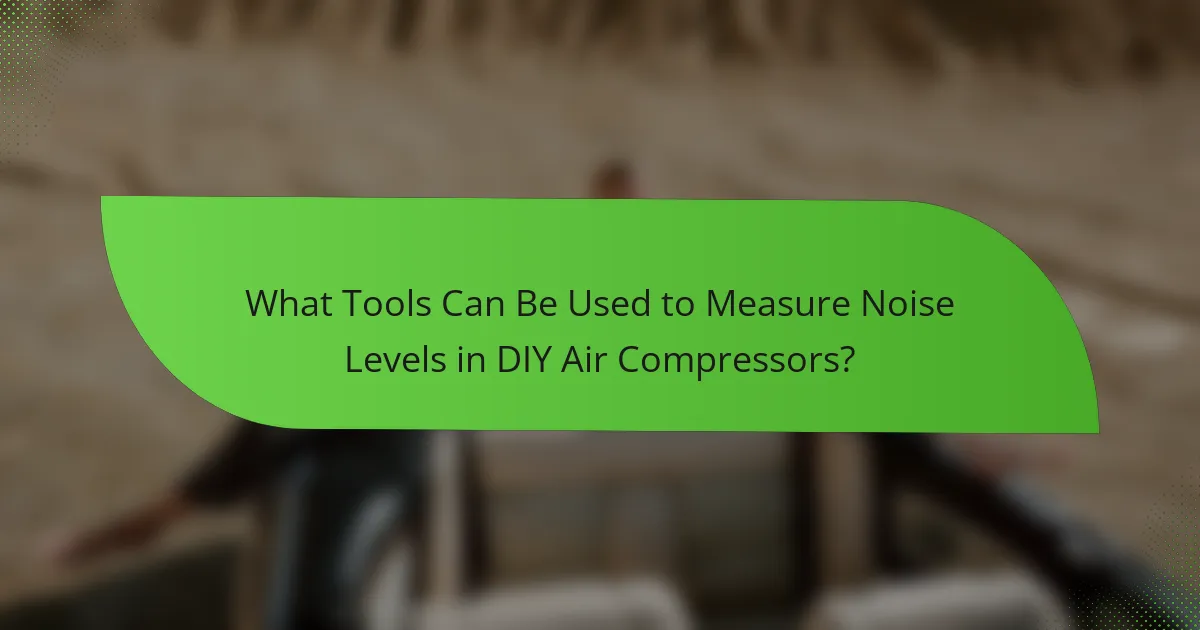
What Tools Can Be Used to Measure Noise Levels in DIY Air Compressors?
Sound level meters are the primary tools used to measure noise levels in DIY air compressors. These devices provide accurate readings of decibel levels. They typically feature a microphone that captures sound waves. Users can select different measurement ranges for precision. Some models offer data logging capabilities for extended monitoring. Smartphone apps can also measure noise levels, though they may be less accurate. Calibration is essential for ensuring reliable results. Professional-grade sound level meters are often used in industrial settings for compliance testing.
What are the different types of sound level meters available?
There are several types of sound level meters available. The most common types include analog sound level meters, digital sound level meters, and integrating sound level meters.
Analog sound level meters use a needle and dial to display sound levels. They provide a continuous reading of sound levels. Digital sound level meters display measurements on a digital screen. They often feature advanced functionalities like data logging. Integrating sound level meters calculate average sound levels over a period. They are particularly useful for measuring fluctuating noise levels.
Other types include environmental sound level meters and precision sound level meters. Environmental sound level meters are designed for outdoor use. Precision sound level meters offer high accuracy for laboratory settings. Each type serves specific applications in noise measurement.
How do handheld sound level meters work?
Handheld sound level meters measure sound intensity using a microphone. The microphone converts sound waves into electrical signals. These signals are processed to determine the sound level in decibels (dB). The meters typically feature a display that shows the measured sound level. Calibration ensures accuracy by comparing measurements to known sound levels. Most meters use A-weighting to reflect human hearing sensitivity. They can record peak sound levels and provide average readings. This functionality is essential for assessing noise levels in various environments, including DIY air compressor applications.
What features should you look for in a sound level meter?
Look for accuracy, range, and response time in a sound level meter. Accuracy ensures precise measurements, typically within ±1 dB. Range indicates the lowest and highest sound levels the meter can measure, often between 30 dB to 130 dB. Response time affects how quickly the meter reacts to changes in sound levels. Select a meter with fast response for dynamic environments. Additionally, consider features like data logging, frequency weighting (A and C), and calibration options. These enhance functionality and usability for various measurement scenarios.
Are there alternative methods to measure noise levels?
Yes, there are alternative methods to measure noise levels. One method is using smartphone applications designed for sound measurement. These apps utilize the device’s microphone to provide sound level readings. Another method involves using a sound level meter, which is a specialized device for measuring noise levels accurately. Additionally, integrating a data logging system can help monitor noise levels over time. These methods provide various options for measuring noise in different environments.
How can smartphone apps be utilized for noise measurement?
Smartphone apps can be utilized for noise measurement by leveraging the device’s built-in microphone. These apps analyze sound levels in decibels (dB) using algorithms to convert audio signals into measurable data. Many noise measurement apps are designed to comply with industry standards for accuracy. For example, the app “Sound Meter” provides real-time dB readings and visual graphs. Studies show that smartphone apps can achieve a measurement accuracy of within ±1 dB of professional sound level meters under optimal conditions. Users can record noise levels over time, allowing for effective monitoring and analysis. This functionality supports DIY projects like assessing noise from air compressors.
What are the pros and cons of using DIY measurement methods?
DIY measurement methods offer flexibility and cost savings. They allow users to create customized solutions tailored to specific needs. This approach can be beneficial for hobbyists and those with limited budgets. However, accuracy may be compromised due to lack of professional calibration. DIY methods can also lead to inconsistent results if not executed properly. Additionally, users may require a learning curve to effectively implement these methods. Research indicates that while DIY methods can be effective, they often lack the precision of professional tools. Thus, users should weigh the benefits against potential drawbacks when considering DIY measurement methods.
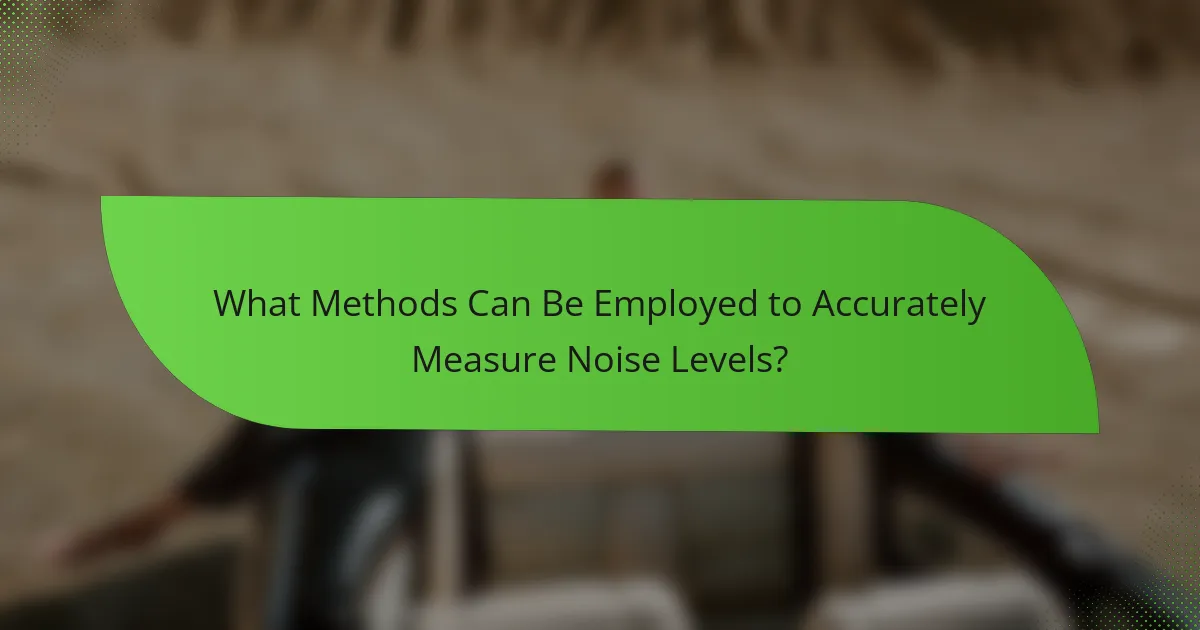
What Methods Can Be Employed to Accurately Measure Noise Levels?
Sound level meters are commonly used to accurately measure noise levels. These devices capture sound pressure levels in decibels (dB). They can provide real-time readings and are often calibrated for precision. Additionally, smartphone apps can also measure noise levels, though they may lack accuracy compared to dedicated devices. Dosimeters are another method, used for measuring exposure over time. They are particularly useful in occupational settings. Lastly, integrating sound level meters with data loggers can help track noise levels over extended periods. This method allows for detailed analysis of noise patterns and trends.
How should you set up your environment for noise measurement?
To set up your environment for noise measurement, ensure a controlled space with minimal external noise interference. Select a quiet location away from traffic and machinery. Use sound-absorbing materials to reduce echoes and reflections. Position the noise measurement device at the appropriate height and distance from the noise source. Maintain consistent environmental conditions, such as temperature and humidity. Avoid placing reflective surfaces near the measurement area. These steps enhance accuracy in capturing true noise levels. Studies indicate that controlled environments yield more reliable noise measurement results.
What factors influence the accuracy of noise measurements?
The accuracy of noise measurements is influenced by several factors. Calibration of the measuring equipment is essential for precise readings. Environmental conditions, such as temperature and humidity, can affect sound propagation. The type of microphone used also plays a critical role in measurement accuracy. Background noise levels may interfere with the readings taken. The distance from the noise source to the measuring device impacts the results as well. Additionally, the placement of the microphone should be consistent to ensure reliable data. Finally, the frequency response of the measuring equipment can affect the accuracy of specific sound frequencies.
How can ambient noise be controlled during measurements?
Ambient noise can be controlled during measurements by implementing various strategies. First, conducting measurements in a quiet environment minimizes external disturbances. Second, using soundproofing materials, such as acoustic panels, can absorb unwanted noise. Third, positioning the measurement equipment away from noise sources reduces interference. Fourth, employing directional microphones focuses on the sound source while ignoring ambient noise. Fifth, utilizing noise-canceling technology can further enhance measurement accuracy. These methods have been shown to significantly improve the reliability of noise level readings in various studies.
What steps should be followed in the measurement process?
Identify the measurement objective. This defines what noise levels need to be assessed. Select appropriate tools for measurement, such as sound level meters or smartphone apps. Calibrate the equipment according to the manufacturer’s instructions to ensure accurate readings. Choose a suitable location for measurement, ideally where the air compressor operates. Record baseline noise levels before activating the compressor. Activate the compressor and take measurements at various distances. Document the readings systematically for analysis. Analyze the data to determine compliance with noise regulations or standards.
How do you calibrate your measuring tools before use?
To calibrate measuring tools before use, follow a systematic process. First, gather calibration standards that are traceable to recognized national or international standards. Next, set the measuring tool to the zero point or reference level as per the manufacturer’s instructions. Use the calibration standards to compare the tool’s readings against known values. Adjust the tool if discrepancies are found, ensuring it aligns with the standards. Regular calibration is essential for maintaining accuracy in measurements. Calibration intervals depend on the tool’s usage frequency and environmental conditions. Accurate calibration ensures reliable data collection, essential for measuring noise levels in DIY air compressors.
What is the best way to document and analyze your findings?
The best way to document and analyze your findings is to use structured data collection methods. Begin by recording measurements consistently using calibrated tools. Use a standardized format for data entry to ensure clarity. Employ software for analysis, such as spreadsheets or statistical programs. Visual representations, like graphs, help in understanding trends. Regularly review your findings for accuracy and completeness. Document the context of each measurement, including conditions and settings. This approach enhances the reliability of your results and facilitates better insights.
What are some best practices for measuring noise levels in DIY air compressors?
To measure noise levels in DIY air compressors effectively, use a sound level meter. This device provides accurate decibel readings. Position the meter at a standard distance, typically 1 meter away from the compressor. Ensure that the compressor operates under normal conditions during measurement. Take multiple readings to account for variability in noise levels. Record measurements at different operational stages, such as startup and continuous running. Compare results against industry standards, like those from the American National Standards Institute (ANSI). This practice ensures compliance and helps identify excessive noise issues.
How can you ensure consistent and reliable measurements?
To ensure consistent and reliable measurements, use calibrated instruments. Calibration aligns measurements with known standards. Regularly check equipment against these standards to maintain accuracy. Control environmental factors like temperature and humidity during measurements. Consistent measurement techniques should be applied each time. Document procedures to maintain uniformity across tests. Repeat measurements to identify any variations. Statistical analysis can help confirm reliability by assessing data consistency.
What common mistakes should be avoided during measurement?
Common mistakes to avoid during measurement include not calibrating the measuring device. Calibration ensures accuracy in readings. Another mistake is measuring in an uncontrolled environment. Background noise can distort results. Failing to maintain a consistent distance from the noise source is also problematic. Variability in distance can lead to inconsistent data. Additionally, not using the appropriate measuring tool for the specific frequency range can result in inaccurate measurements. Finally, neglecting to take multiple readings and averaging them can lead to misinterpretation of noise levels. Accurate measurements require careful attention to these factors.
The main entity of this article is DIY air compressors, specifically focusing on the measurement of their noise levels. The article provides an overview of the typical noise levels produced by various types of compressors, the tools and methods used for measuring these levels, and the importance of monitoring noise for safety and compliance. It discusses the use of sound level meters and smartphone apps, calibration techniques, and best practices for obtaining accurate measurements. Additionally, the article addresses common mistakes to avoid and the impact of noise on user experience and safety.
